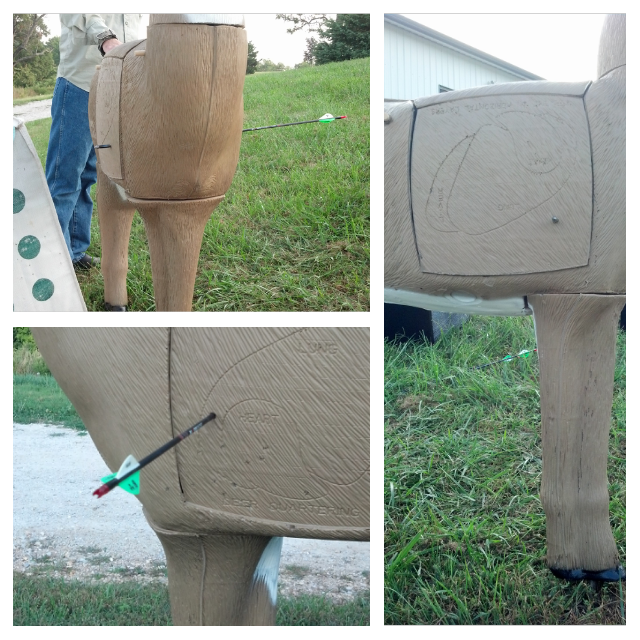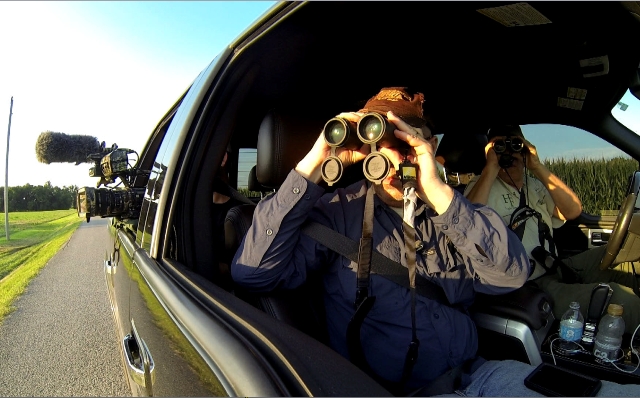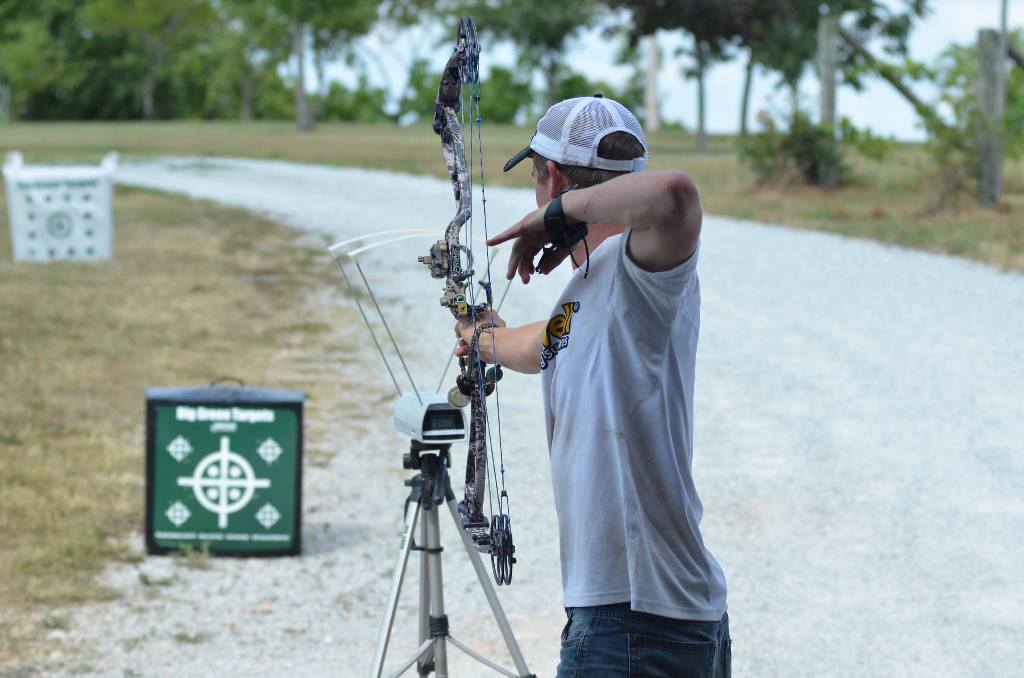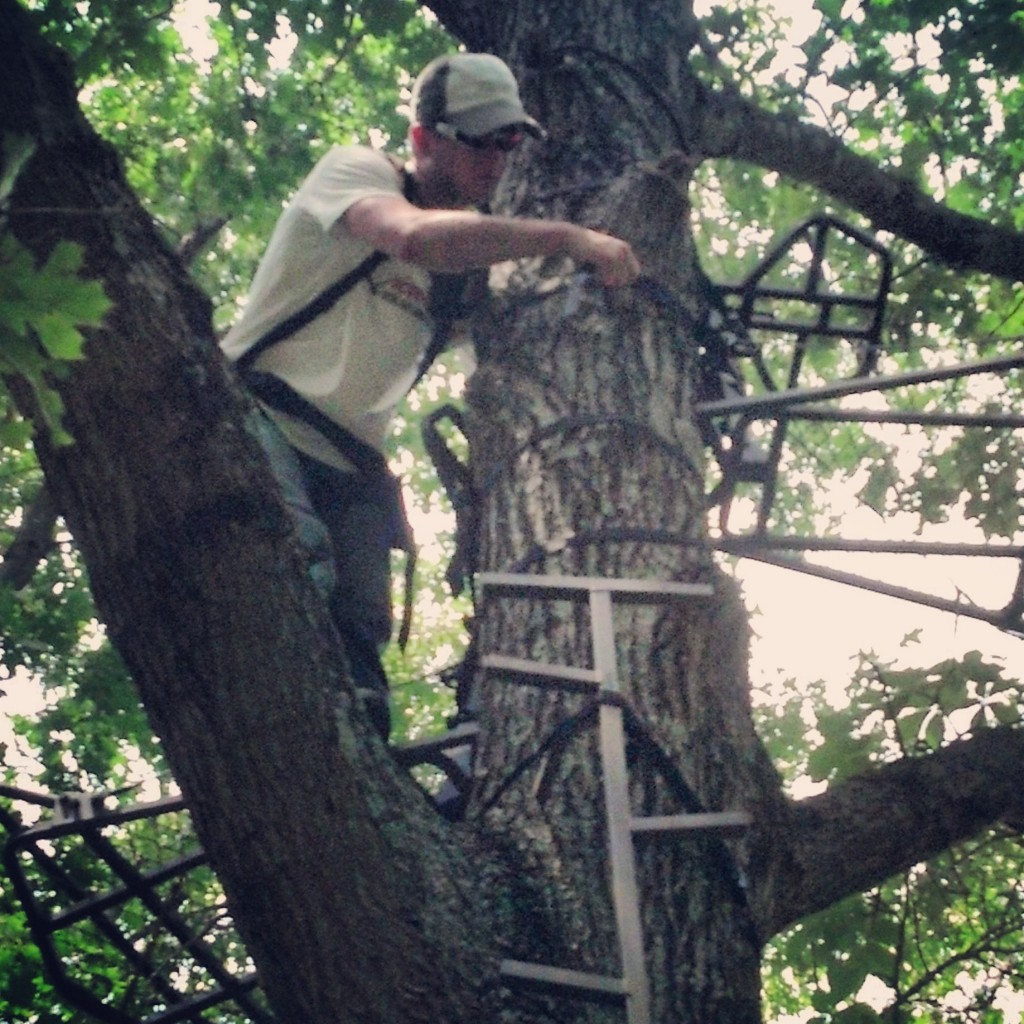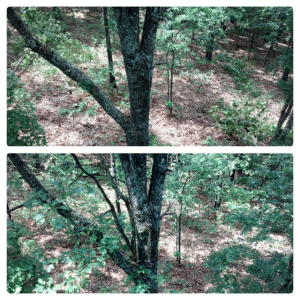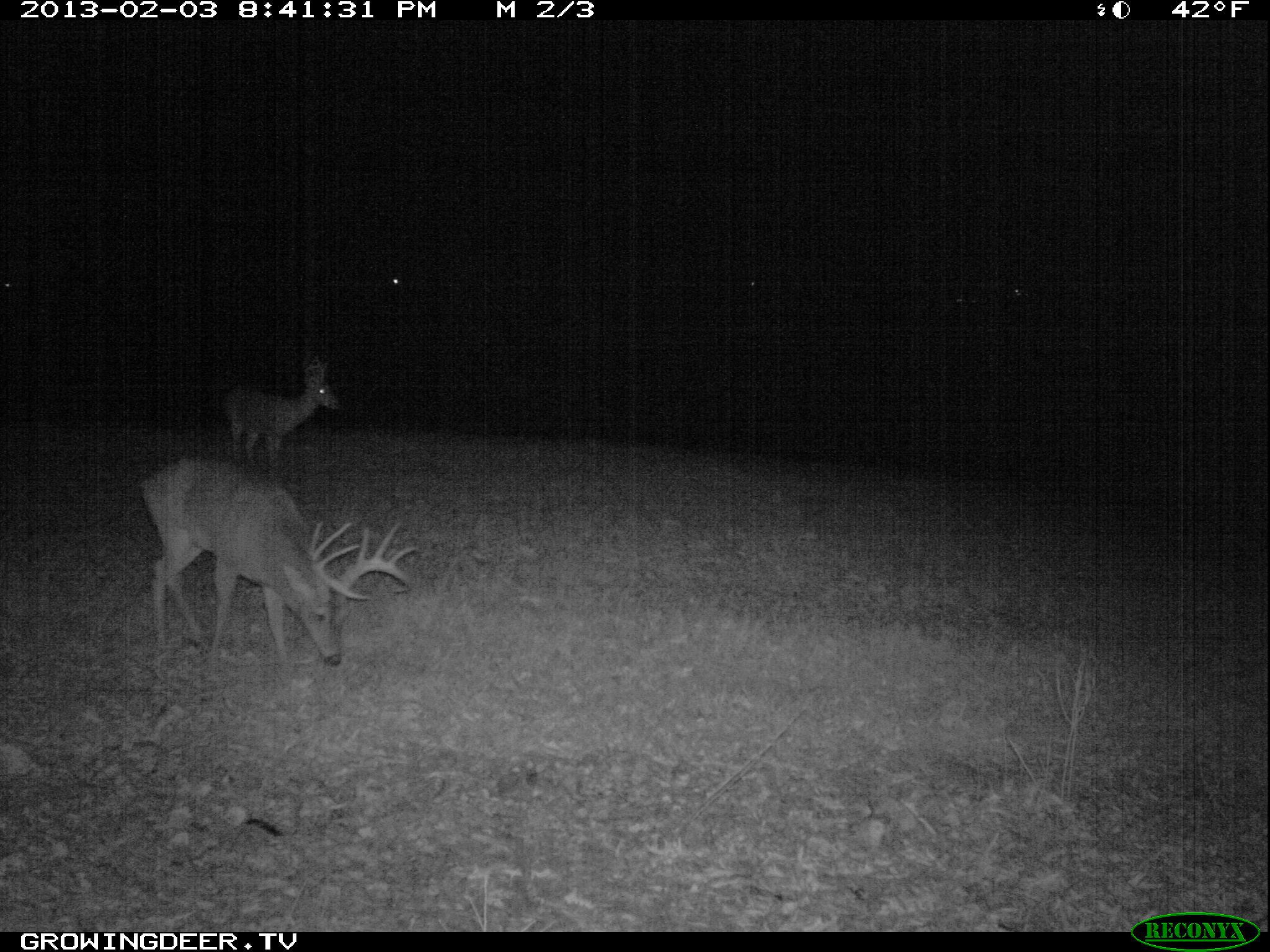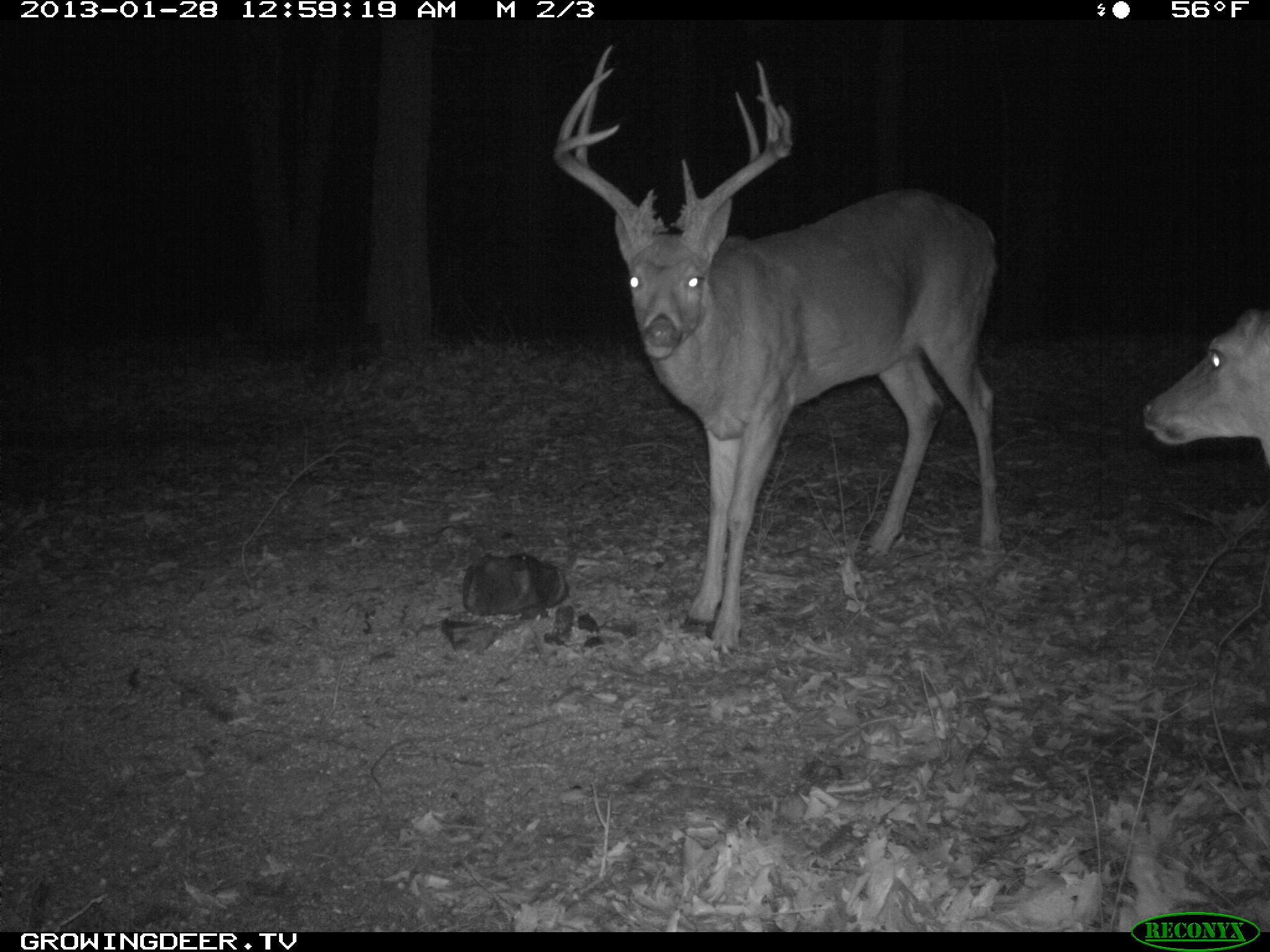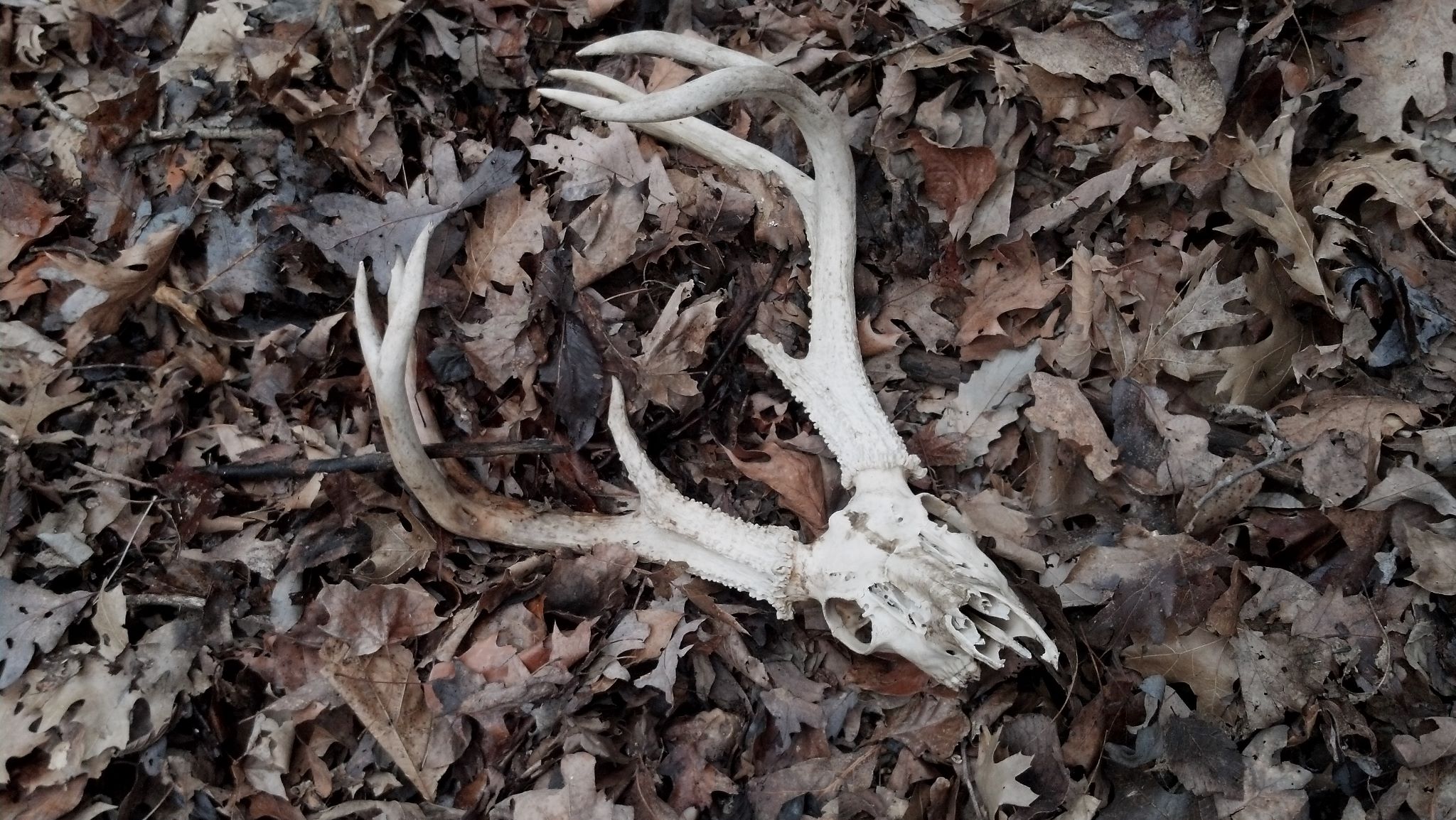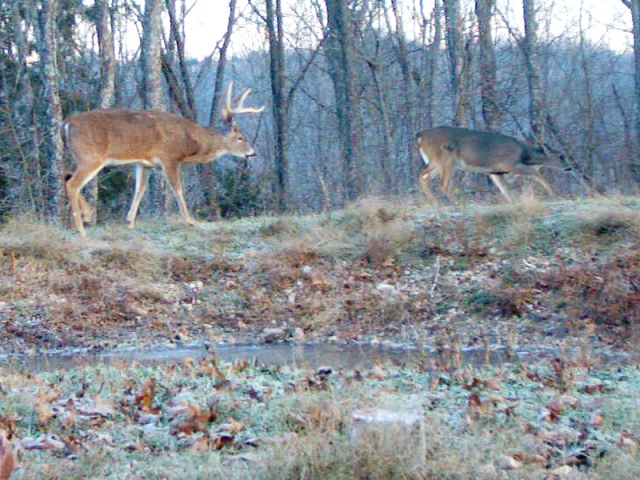Category: Deer Hunting
Deer Hunting: Realistic Practice Puts Tenderloins In The Freezer
I enjoy shooting both guns and bows! I was raised by a family that shot competitively. My father, mother, and both sisters and I have won numerous shooting matches in the National Muzzleloader Rifle Association’s competitions. I give all the credit for the wins to my father, Glen Woods.
My dad always had us practice in the same positions, at the same ranges, and at the targets we’d see at the upcoming matches. He’d also mix in some fun, like shooting at novelty targets.
The skills I learned as a child while being “coached” by my father have helped me through the years. However, just the knowledge of how to shoot won’t put many tenderloins in the freezer without continual practice.
I believe it is just as important for hunters to practice shot placement as it was for me as a competitor to practice with the exact conditions I would see during matches! A great method to do this is to practice using 3D targets! It’s very easy to focus on where the arrow/bullet strikes the target, especially paper targets. To consistently bring home tenderloin, knowing where the arrow/bullet exits is as important as the entrance.
To take this a step further, I like to practice with the broadheads and bullets I use to hunt with. Finally, I like to simulate the conditions of shooting at a critter versus practicing quietly by myself. I often have my buddies shoot with me and encourage them to be talking, teasing, etc., while I’m shooting.
Finally, I continue practicing during season. It’s easy to practice all summer and be shooting great at the first of the season. However, it’s easy to spend all of our free time hunting once season begins. As the temperatures change most hunters will wear different/more clothes. This can radically change the sight picture of shooting a bow and/or gun. In addition, muscle tone developed by frequently practicing with a bow can decrease substantially in a few weeks if the practice frequency or duration decreases.
I’ve been practicing with my hunting gear, and will continue practicing throughout the season. How about you?
Growing and hunting deer together,
Grant
Scouting For Early Season Hunts!
Many hunters, including myself, are “scouting” for stand locations this time of year! However, we don’t and shouldn’t always have to spend days busting through the woods to find stand locations.
If the goal is to find and harvest a mature buck then the least disturbance we can cause while scouting and still obtain useful information is better. Mature deer have some level of memory. That can serve hunters well if deer use their memory to return to the same food source, bedding area, or water source.
However, a deer’s memory can also limit the success of hunters if deer avoid areas due to associating (remembering) that area with fear. So, I prefer scouting using Minimal Disturbance Entry (MDE).
In areas where soybeans and other crops that deer prefer are grown, scouting may be as simple as cruising the roads around the area where you hunt. Often mature bucks can be seen foraging in soybean fields just before dark. Watching bucks this way is fun, but is only the first step in this scouting technique.
Once bucks are located and you’ve confirmed that they are returning to the same field it’s time to use the best scouting tool – your brain!! Rather than go into that area and risk putting the bucks on high alert, consider where the closest bedding area is. Is there a bottleneck such as a narrow strip of woods, pinch point between cover and a river, fence gap, etc., between where the bucks are feeding and where you believe they are bedding?
If so, then consider if you can approach that area to hunt without alerting the bucks to your presence. If there is then you’ve found a great stand location! Remember that bucks often change patterns and use other parts of their home range during the next few weeks as the soybean forage begins turning yellow and the bucks’ hormones change. Once you’ve located a buck this time of year, careful scouting and stand placement can lead to filling a buck tag within the first few days of the season!
Just before and soon after bucks shed velvet they are usually on a food/cover pattern. Locating the preferred food and cover – and just as importantly, a stand location in between that allows the hunter to approach, hunt, and exit without alerting deer — is a great scouting technique!
Growing and hunting deer together,
Grant
Time To Get Ready For Deer Season!
We’re rolling into the end of July and the GrowingDeer Team is neck deep in preseason projects to help us prepare for the upcoming hunting season! I thought I would take some time this week to discuss those projects so you could get a better understanding of what our preparations are and what you can do to prepare for hunting season.
Most deer hunters across the US are starting to brave the heat and take to the woods to check/move and trim deer stands. Checking stands is very important! We do it this time of year because stand maintenance is crucial; plus you certainly don’t want to be trimming lanes during hunting season – ultimately alerting deer and turning them completely nocturnal. One important piece of advice on preseason stand preparations is checking your stand straps as with each year it becomes more and more important as the straps get older and spend more time in the elements. Squirrels, mice, etc. will also chew on these straps making them weaker, so always be sure to use two straps on each stand and always check them before climbing in your stand.
If you caught Grant’s blog last week you know that we’re also getting ready for our trail camera survey! This involves everything from making sure all settings on our Reconyx trail cameras are correct and the Redneck feeders are all up and ready for August 1st when the survey begins! This activity also means that I’m watching as much TV and movies as possible… now you’re wondering what the connection is? When you’re trying to come up with a unique/creative name for each buck caught on camera on a 2,200 acre ranch, you need to load your brain up with as many different names as possible…
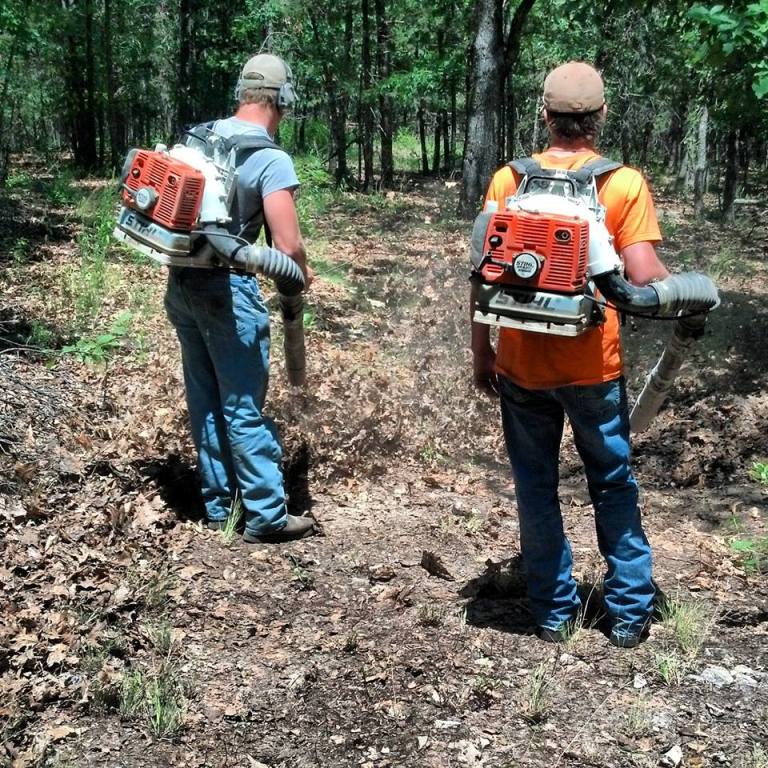
We prepare for future years of hunting with growing season fires. These fires insure quality habitat for all types of wildlife.
Even with these two main projects going on, we’re still finding time to practice our growing season fires (Watch GDTV 189)! Unlike our first two projects where we are focusing on this calendar year’s hunting season, it’s equally important to prepare for future years of hunting! One way we do this is by insuring quality habitat for all types of wildlife by practicing growing season fires. Be sure to catch upcoming episodes of GrowingDeer.tv to learn more about growing season fires.
The last two preseason projects we are doing are my favorite by far! Organizing your gear and getting it ready for opening day is very important to success! We’ll be completely washing all our camo in Dead Down Wind products, air drying them on the clothes line and storing them in our ScentMaster Locker. Although I’m not a huge fan of laundry in my everyday life, when it is camo I can feel the excitement growing! Who knew laundry could be so exciting!? We also spray down other gear, binoculars, camera arms, safety harnesses and store them. As most of the loyal fans know scent reduction is huge for us, we live, breath, and eat scent reduction! Especially at The Proving Grounds when we’re fighting thermal shifts constantly!
Lastly, and definitely my favorite step in preseason preparations: Shooting! Most serious bow hunters shoot their bows year round. As the calendar pages turn and the velvet begins to grow and antlers start forming, shooting becomes more serious. Most hunters begin feeling like a kid on Christmas Eve! This time of year I’m starting to shoot more and more, extending out to find my comfortable range. I’m doing everything I can to make sure when that time comes this fall, I’m ready to squeeze the trigger with the confidence that I’ve done all the preparation to make the shot!
It’s an exciting time of year, so get out there and have some fun getting ready for the upcoming season! As always, be safe!
Daydreaming of whitetails,
Adam
Deer Hunting Tasks: Why Trim Shooting Lanes During June?
We’ve been hanging Muddy tree stands this week. It’s hot in Missouri here, with heat indexes over 100 degrees. We posted a picture of us while hanging stands on the GrowingDeer.tv Facebook page and someone responded “Why trim shooting lanes during June?”
That’s a good question! We primarily hunt our farm each year. We are constantly working on food plots, sanctuaries, Trophy Rock stations, trail camera surveys, shed hunting, etc. We continue learning how deer use this property during different conditions.
So we usually move some stands each year and/or trim different shooting lanes for existing stands. Hanging stands and trimming shooting lanes is hot, sweaty, noisy work. Mature bucks have some level of memory. In addition, it appears fear is their biggest motivation! It’s easy to see how mature deer could associate a stand location with fear if they experience loud noises and odors they associate with danger.
Therefore I prefer hanging stands and trimming shooting lanes as soon as the vegetation has grown most of what it will for the summer (new growth on trees is mostly complete by mid June). This means I won’t have to re-trim shooting lanes again during the fall and the area will have had months of no disturbance before hunting season.
If I wish to hang a stand during hunting season, I limit the amount of disturbance and vegetation trimmed to the minimum necessary to see and shoot. Excess disturbance during hunting season can substantially reduce the chances of harvesting a mature buck from that stand – no matter how hot the sign was that prompted you to hang at that location.
Remember, fear is probably the biggest motivation for mature bucks. Limiting disturbance near stand sites is critical to successfully harvest mature deer year after year.
Growing (and hunting) Deer together,
Grant
Scouting Whitetails In February for November Success
If you’ve paid any attention over the past couple of weeks you’ve seen our GrowingDeer.tv episodes, tweets and Facebook posts have consisted mostly of bucks that have been found dead on The Proving Grounds due to the outbreak of EHD late last summer. Now if you’re anything like me you might be getting sick of talking about deer that you’ll never be able to hunt. So today we’re changing things up and thinking “happy thoughts.”
There are still a few nice bucks running around here, one that you’ve probably heard us talk about before is a 6.5 year old or older buck named Split Brow. Another great buck that showed up on Boomerang Ridge this year is Two Face. Both of these bucks were still holding their antlers in early
February when we ran our Reconyx cameras, but it’s that time of year when they can fall off at any moment, so we’re taking any spare moments we get to do a little shed hunting!
One of the great things about shed hunting, besides finding those treasured antlers, is finding the trails, scrapes, rubs, and all the other sign that you didn’t know existed because they were in areas you didn’t want to intrude on during hunting season. That’s the great thing about walking your property during January and February, all the deer sign that was left during hunting season is still present. This means you might be able to find those trails that the mature bucks were using to sneak through your property unseen. With this in mind, anyone who’s ever shed hunted with me knows I’m terrible at it! I have to almost step on the antlers to find them. The biggest reason why I’m so bad at shed hunting is the deer sign I mentioned. When I’m walking through the woods and find a very active deer trail, then maybe a large rub on a tree, followed by a scrape, I’ve stopped focusing on finding sheds and I’ve already started looking for a tree to hang a Muddy treestand in.
While collecting soil samples and shed hunting last week, if I noticed a large deer trail coming into a food plot, I would take a short recon mission and see what I could learn. As the week came to a close I had found nine new locations to hang Muddy stands in. Nine new stands in places we didn’t hunt at all last year, plus they’re loaded with deer sign! Needless to say we are only a few weeks into February and I’m already excited about the upcoming season!
It’s a great time of year for shed hunting but don’t forget to keep those eyes peeled for possible hunting locations. You could be missing out on that secret spot where your Hit List bucks hide!
Dreaming of Giant Whitetails,
Adam
Shed Antler Hunting: The Aftermath of EHD
It’s been a busy week here at The Proving Grounds. Missouri trapping season is coming to a close and we’re also in the middle of our post season camera survey. These days are usually busy for the GrowingDeer.tv Team as we check our Duke Traps every morning and replenish the Record Rack feeding stations. It was during this time when I received a phone call from Mrs. Tracy saying she had found a “sure enough big buck.”
As many of our loyal viewers know, Mrs. Tracy loves to shed hunt with her dog, Crystal. Grant, Brian, and I are leaving January worn down from the long haul of deer season but Mrs. Tracy is just getting fired up! With the close of archery season on January 15th Mrs. Tracy heads to the woods to start looking for sheds and skulls of the bucks who didn’t survive the season. Especially after this year, with the outbreak of EHD (Epizootic Hemorrhagic Disease), as the shed hunting enthusiasts start their search for those treasured antlers, they will have their hands full of EHD stricken deer remains. There are a couple reasons why I feel this will happen.
We are beginning to switch out of hunting and back into the management side of things. We are starting to enter into parts of the property that have been left untouched during the hunting season. As we’ve started doing these projects we have been finding carcasses, both recent and from months ago when EHD hit the hardest. For example, Monday we began collecting soil samples and in a few hours of work we had already found two carcasses by the creek we were working by.
As the season progressed here at The Proving Grounds we noticed that some of our bucks had come up missing. First there was Bean Flipper in late August, then Tightwad in mid-September, next Giant 8 in late September and finally Pumpkin face (after a firsthand encounter in early November). Typically bucks are not as easy to pattern during the rut but as we enter a late season feeding pattern we would expect to see them on our Reconyx cameras. We’re now almost into February and still haven’t seen “hide nor hair” from these bucks, until I got the phone call.
I could hear the excitement in her voice and I was just hoping she couldn’t hear the disappointment in mine. She had found a large buck dead and now my only thought was, “Who is it?” She sent a picture to my phone and based on what looked like split G2s my instincts told me it was Bean Flipper. After we hiked down the valley to her and the buck, I put my hands on the antlers and crossed Bean Flipper of the MIA list. You can catch the entire recovery on next Monday’s episode at GrowingDeer.tv (GDTV 167).
As we make our way into the post season/shed hunting time of year, the GrowingDeer.tv Team will start focusing on who survived and who still remains MIA, and we’ll bring it all to you right here semi-live!
Good luck to all of you planning on hitting the woods searching for sheds!
Dreaming of Giant Whitetails,
Adam
Managing Whitetails: Habitat Design
This morning I toured a 280 acre tract of land recently purchased by the owners of Redneck Hunting Blinds. The property is in west central Missouri. It’s about 50% tillable land and 50% hardwood forest. A power line and a gas right of way cross the property. Basically the timber is on the west of the property and the crop ground on the east.
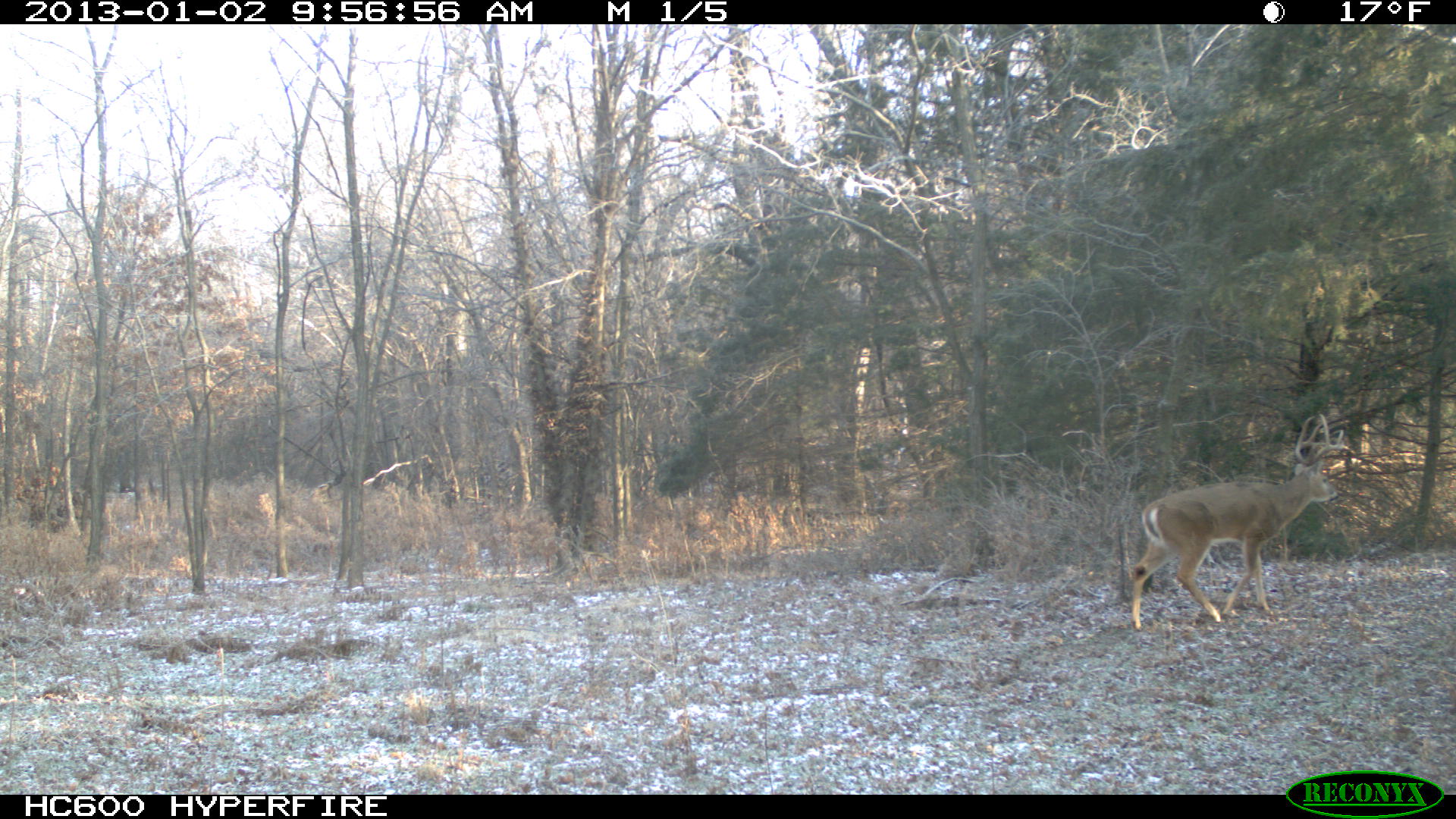
It’s a long way from finding one set of sheds to producing and harvesting two mature bucks annually.
The area has much potential as we found both sheds to the buck in this picture. However, it’s a long way from finding one set of sheds to producing and harvesting two mature bucks annually.
My goal is to design a habitat management and hunting strategy that will yield an average of two mature (4+ year old) bucks to harvest annually – or a mature buck per 100+ acres. That’s a very tall order! However, the habitat is conducive to that objective. I’m not sure about the neighborhood yet.
I always begin by assessing the availability and quality of food, cover, and water. It seems most folks focus on food – either row crop or food plots. However, deer, especially mature bucks, spend the majority of their time during daylight hours in or near cover. This is especially true in areas where row crop ag is the primary land use – especially after the crops are harvested.
The Redneck Proving Grounds has some cover, but no sanctuaries. That’s to say there were no areas where there wasn’t sign (treestands, ATV trails, etc.) of hunting activity. One of my first thoughts during the tour was that I need a plan to encourage mature bucks to spend a majority of their time on the Redneck Proving Grounds. I will accomplish this by creating three sanctuaries in different corners of the properties!
Let me know if you’d like to follow this project closer and I’ll share step by step my plans and the progress.
Growing Deer together,
Grant
Coyotes and Whitetails
Adam and Brian are in Kansas filming a late season bow hunt. Yesterday afternoon about prime time some does and young bucks were in the food plot Adam and Brian were watching as they eagerly waited for a mature buck to approach. Then several of the deer on one side of the field sprinted away with two coyotes in pursuit. Many hunters have shared this observation with me recently – seeing deer chased by coyotes.
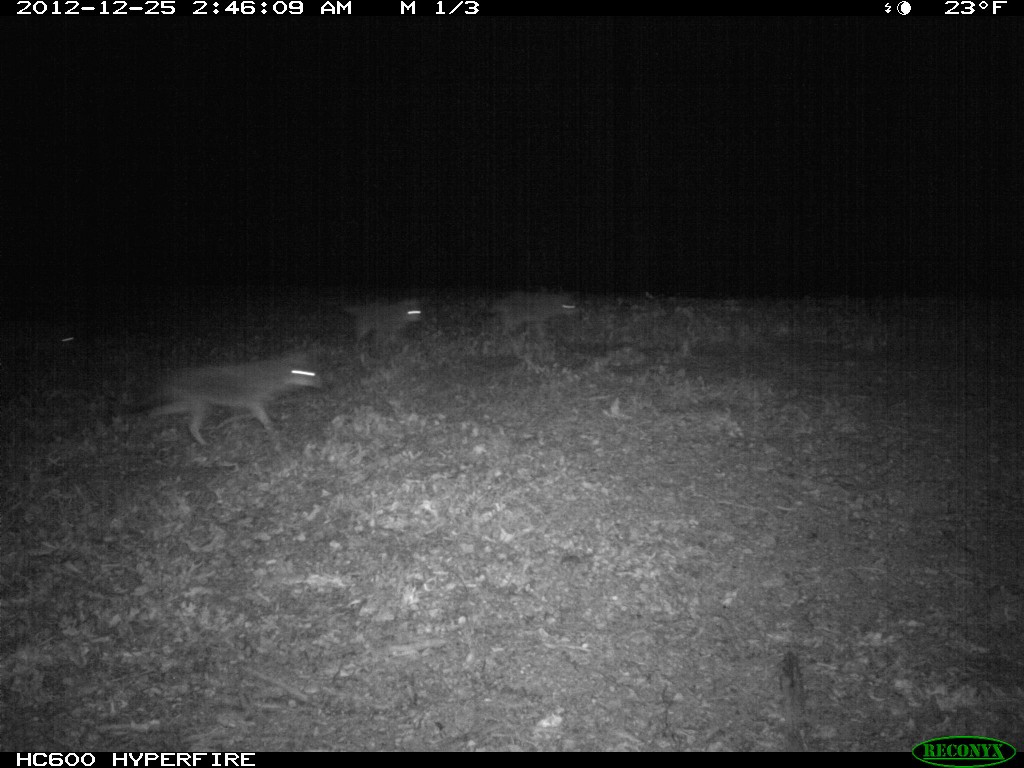
Many hunters have shared seeing deer chased by coyotes recently.
Several research projects during recent years has documented that coyotes are killing a significant portion of fawns in some areas. It’s also been documented that coyotes (and other predators) can cause significant stress or mortality to adult deer.
Even if this research hasn’t been repeated in the state where you hunt, you can look for signs of predator/prey populations being out of balance toward predator species. Do you often see adult deer being stalked or chased by coyotes? Do deer where you hunt act extremely wary or alert when a coyote howls? Do you get trail camera pictures of multiple coyotes together?
Coyotes weren’t considered to be pack hunters when I was in graduate school (many years ago). However, coyotes have been documented to have interbred with gray wolves in the northeastern states and Canadian provinces. Large “coyotes”, such as 80+ pounds, have been documented in states as far south as my home state of Missouri.
Genetic testing has shown that some of the large “coyotes” are actually wolf/coyote hybrids while others are dog/coyote hybrids. In both cases these hybrids are certainly capable of killing adult deer, and tend to hunt in packs more than pure coyotes.
Coyotes (and other predators) were hunted frequently when I was a child by farmers that were protecting their stock and by trappers that gained income by selling their pelts, glands, etc. However, the number of farmers, ranchers, and trappers has decreased substantially during the past 20 years.
The number of coyotes has increased significantly in many states as well as the average size of coyotes in some areas. It’s time for hunters to help bring back a healthy balance between predators and prey species in many areas. I’m loading up my Winchester ammo and FoxPro caller and going out to do my part.
Growing Deer together,
Grant
Changes In Hunting Strategy: Fawn Predation
As I explained in my blog last week, Hunting Strategies: The Late Rut, my primary buck hunting strategy this time of year is geared around fawns. Female fawns reach puberty when they’ve grown enough to weigh about 70 pounds throughout most of the whitetails range. That’s obtainable in most areas if there is adequate quality forage and a fairly balanced adult sex ratio. One of the many benefits of a balanced adult sex ratio is that there are plenty of bucks available to breed the does as soon as they become receptive.
These fawns often reach puberty during the later portion of deer season which causes a flurry of rutting behavior. In areas where the deer herd is “tuned up” (a balanced adult sex ratio, older age class bucks present, and ample quality forage to allow deer to express most of their body and antler size potential) female fawns typically reach puberty about a month or so after adult does. This flurry of rutting behavior is often called the “secondary rut.”
I live and hunt on an island of deer management. I’m only aware of one neighbor (out of 34) that establishes food plots (although the game wardens have made a few cases of folks hunting over bait), passes up immature bucks, or attempts to harvest as many does as bucks. I’m truly an island in a sea of properties that simply shoot deer – primarily young bucks.
Even though my property is a deer management island, I’ve been able to improve the habitat enough that a substantial percentage of female fawns in my area reach puberty and bred during their first winter (there’s hope for all you “island” deer managers)!
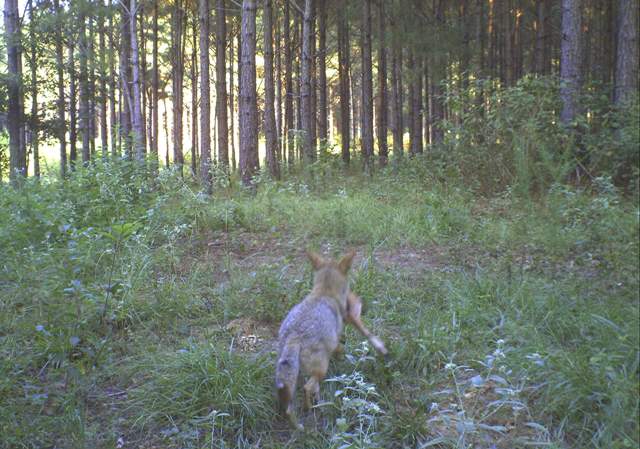
Coyotes are tremendous fawn killers, 60%+ of all fawns born in an area are killed primarily by coyotes.
However, if there aren’t many female fawns, this exciting hunting opportunity won’t happen (as well as several other negative impacts to the deer herd). That’s one reason I trap and hunt coyotes. Coyotes are tremendous fawn killers. They tend to kill fawns during the first few hours and weeks after the fawns are born. Amazingly, several university research projects have shown 60%+ of all fawns born in an area are killed by predators, primarily coyotes in most studies. This has huge impacts on the herd.Once you’ve digested that information, realize that the number of coyotes is rapidly increasing in many areas, especially in eastern states! At 60% +/- fawn mortality, there won’t be many fawns reaching puberty the following fall and therefore the fawn/food source hunting strategy won’t work. Actually, after a few years of heavy fawn mortality no deer hunting strategy will work well because there won’t be many deer!
That’s why I trap and hunt coyotes! Just as good stewards work to balance adult sex ratios and provide ample quality forage, they should also work to balance the predator/prey relationship so neither get out of balance and do long-term damage to the habitat or other species of wildlife. In many areas, removing predators benefits the deer herd and deer hunters as much as other deer management activities.
I’m out to check my traps now, and I’m spending most afternoons watching food plots and enjoying seeing fawns! I’m very confident one of them will have a mature buck following.
GrowingDeer together,
Grant
Hunting Strategies: The Late Rut
This time of year I always hear a lot of talk about the “late rut.” It’s often used in discussions about hunting strategies and stand placement.
Throughout most of the whitetail’s range, most does become receptive during early November. This is based on literally 10’s of 1,000’s of fetuses removed from harvested does and aged to determine their conception dates. With years of these data it’s clear that moon phase, weather, etc., doesn’t impact when deer breed. The only significant change in breeding dates for specific herds/properties that I’ve documented (or heard about) were caused by hunters purposely altering the herd’s adult sex ratio. They changed the herd’s adult sex ratio by harvesting more does and passing young bucks on properties where the deer harvest had been predominately bucks for years. I’ve documented a shift in the average breeding date of more than 30 days as a response to a few years of working to balance the adult sex ratio. As a result of these efforts the hunting also improved substantially as more mature bucks were competing for does. The bucks responded to rattling, grunt calls, decoys, etc.
The more balanced the adult sex ratio, the shorter and more intense the rut will be. For example, if the deer harvest in an area where you hunt has been close to being balanced (as many does as bucks) for a few years, then expect a few does to become receptive early, a flurry of breeding activity, and then the breeding activity tapering off. Imagine a bell-shaped curve of breeding activity. The right side of the bell is usually a gentler slope (the breeding activity may tapper off slower than it started) than the left side.
Female fawns usually reach puberty and become receptive if they reach 60-70 pounds during their first fall/early winter. In soybean and corn production regions, areas with high quality native habitat, properties with a substantial amount of quality food plots, etc., many female fawns will become receptive. Depending on the quality of the habitat, this can vary from a very small percentage of the female fawns (usually in areas where timber is the primary land use) to 80+% in areas of Iowa.
In areas where a high percentage of female fawns do reach puberty during their first fall, the amount of bucks seen cruising, chasing, etc., certainly appears like a second rut! This is simply one more reason to manage for a balanced adult sex ratio and high quality habitat. This work not only will allow bucks to produce larger antlers, but create better hunting throughout a longer period of time!
Simply stated, the intensity of the” late rut” is strongly related to health of the female fawns in that area. The health of female fawns is determined by the herd and habitat quality. You can enjoy an action packed late rut by either hunting in agricultural production areas or working to improve the herd and habitat quality where you hunt.
I live on an island of quality deer habitat – literally. I live and hunt where timber and fescue (same as a biological desert) are the primary land use. I’ve worked to improve the habitat and have created quality hunting in a white-tailed deer habitat desert. You can enjoy the “late rut” anywhere, even if you hunt on an island like me. However, those of us that hunt on an island must work a bit harder to enjoy the same quality of hunting as those that hunt in corn and soybean production areas!
Growing Deer together,
Grant



